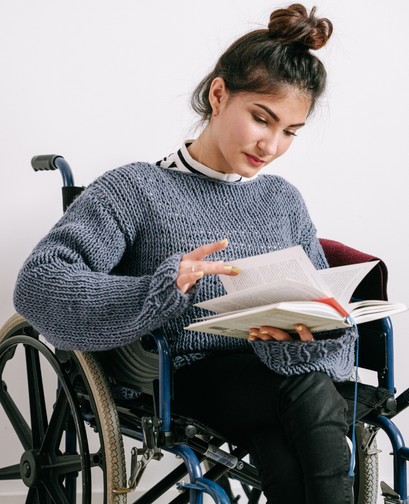On this website, you might come across some terms, concepts or acronyms that you might be unfamiliar with. Below, we’ve listed many of these for your reference.
If there’s anything missing from this list, or if there’s anything you’d like to enquire about, please don’t hesitate to get in touch with us! We’re always happy to help.
We’d like to take a moment to let you know about our position around the use of certain language. At Reframing Autism, we embrace the neurodiversity paradigm. This takes the basic concept of neurodiversity (“all brains are different”) and proposes that, while some brains are neurotypical (that is, broadly conforming to a standardised, typically developing norm), and some brains are neurodivergent (that is, diverging from that standardised, typically developing norm), all brains are valued.
Importantly, the neurodiversity paradigm argues that divergent brains – and, by natural extension, Autistic brains – should exist alongside neurotypical brains, without judgement. We are not “disordered” (a subjective judgement) because of our neurodivergence. It proposes that typically developing brains are no more “right” or “desirable” than divergent brains.
Because this position is foundational to our work at Reframing Autism, many of the definitions provided in this glossary are constructed within this lens.
We also reject the use of potentially harmful therapies, which are those therapies that are intensive in nature or promote Autistic masking or the suppression of Autistic behaviours. . We’ve listed the definitions for some of such therapies below as context only, as they are sometimes mentioned as part of the broader discussion around Autism.

AAC: Acronym for “Augmentative and Alternative Communication”. AAC includes all the ways in which it is possible to communicate without talking; can either be aided (a tool or device) or unaided (body language, gestures, or sign language).
ABA: Acronym for “Applied Behaviour Analysis”. ABA is a behavioural therapy with a focus on making Autistic people seem less Autistic, sometimes discussed with the goal of “losing” the diagnosis; strongly opposed by the Autistic community due to its links to PTSD and its encouragement of masking through coercion.
Ableism: Discrimination and social prejudice against people with disabilities based on the belief that typical abilities are superior, and that disabled people require “fixing”.
Acceptance: In the context of Autism, many advocates prefer Autism acceptance to Autism awareness, since awareness is passive and othering, whereas acceptance requires actual work and leads to belonging.
Accommodations: Used to describe an alteration of environment, curriculum format, or equipment that allows an individual with a disability to gain access to an environment, content and/or complete assigned tasks.
Activism: A type of advocacy that requires purposeful and vigorous actions to campaign for social or political change towards a perceived greater good.
Adaptive morphing: A potential alternative, and more respectful, term for “masking” or “camouflaging”; a social survival strategy that involves adjusting behaviour to reflect what is expected by society; comes at a heavy cost to mental health.
Advocacy: The act of publicly supporting a cause, recommending a policy, or putting a case for something on someone else’s behalf; can be self (related to one’s own cause and needs), or systemic (related to broader social, political, policy changes).
Alexithymia: A neurological difference which results in atypical methods or challenges in identifying and/or communicating emotion.
Allistic: non-Autistic, the opposite of Autistic.
Aphantasia: A neurological difference which results in atypical methods or challenges in visualising or imagining.
Asperger’s Syndrome: An outdated subset of an Autism diagnosis, characterised by average to above-average cognitive function, differences in communication and social language (pragmatics) and, sometimes, a limited range of interests or obsessive interest in a particular topic. Asperger’s used to also be referred to as “high functioning” Autism. Asperger’s is no longer recognised as a diagnosis (since the release of the DSM-5 in 2013), and has been folded into Autism Spectrum Condition.(Note: Reframing Autism rejects the use of the term Asperger’s Syndrome, and other colloquialisms such as “Aspie”, which fragment our community and miss the complexity of individual strengths and challenges).
Assistive technology: Electronic as well as non-electronic materials, equipment and devices designed to help people with disabilities play, learn, communicate, move around and carry out activities of daily living at home, at school, and in the community.

Attachment theory: A theory of child development that centres on the relationships between children and their caregivers, and measures the impact of these relationships on the child’s neurobiological development.
Attachment, secure: An attachment style in which a caregiver is consistently sensitive and responsive towards their child, leading the child to feel safe that their caregiver will respond to their needs; children feel safe, seen, soothed and secure; children with secure attachment enjoy more happiness, have higher self-esteem, trust the people they love, and enjoy their relationships more, when compared to children with insecure attachment.
Attention Deficit Hyperactivity Disorder (ADHD): The diagnostic term used to describe people who have significant differences in their executive functioning profiles, including in the ways they concentrate, focus, engage, remember, and use movement to process information.
AuDHD: An individual who is both Autistic and with ADHD (or Attention Deficit Hyperactivity Disorder). Autism and ADHD commonly co-occur.
Authenticity: The act of being true to oneself; thinking, behaving, and communicating in genuine ways that accord to one’s morals, neurology, identity, ethics, and culture; the foundation of “intactness” and the antithesis ofmasking.
Autism community: A community with a connection to Autism (e.g., medical and allied health professionals, teachers, non-autistic parents of Autistic children, etc.), but whose members are not themselves Autistic typically. Note that you can be a member of the Autism community and be Autistic but the dominant neurotype in the Autism community is not Autistic.
Autistic community: A community consisting only of Autistic people, whether self-identified or formally identified.
Autonomy: The ability to make one’s own choices, free from undue external control or influence; sometimes also known as self-determination.

Bidirectionality: Denoting reciprocity, mutuality, or the concept of a metaphorical “two-way street”; used most often in the context of communication or social pragmatics; used also in the context of the “double empathy problem”, in which both Autistic and non-autistic people experience a mutual disconnect with the other group.
Behavioural therapy: The systematic application of behavioural theory, including the use of conditioning and reinforcements, to modify behaviour.
Burnout (Autistic): A state of intense physical, mental, or emotional exhaustion that comes from an extended period of an Autistic person being overburdened by the demands of a non-autistic world.
Camouflaging: A term often used in research and academic contexts to indicate Autistic “masking” (see “adaptive morphing” above).
CCN: Acronym for “Complex Communication Needs”. CCN refers to severe challenges in speech, language and communication.
Challenging behaviour: An Autistic person’s response to distress or dysregulation that is pathologised or misunderstood by non-autistic people as it proves “challenging” to the observer; this pathologised viewpoint allows non-autistic people to abrogate responsibility for contributing to the underlying cause of behaviour.
Cognition: The ability to perceive, think, reason, and analyse.
Cognitive ability: An individual’s intellectual ability or the aggregate skills of knowing and understanding.
Consent: Agreement, approval; needs to be informed to be genuine.
Co-production: An approach (usually in research) where power is shared between researchers and the studied community across the research lifecycle, to produce respectful, relevant and meaningful research aligned to community preferences and priorities; the emphasis is on collaboration or working in partnership to define projects and solutions.
Cure: To fix or treat permanently; underpinned by the perception that whatever is being cured is wrong or deficient and therefore needs to be fixed.

Deficits-based approach: Focuses on the perceived weaknesses or deficits of an individual; assigns the responsibility for perceived deficits to the individual; used in the “medical model” of disability and Autism.
Developmental delay: A slower rate of development in comparison to the majority of children of the same age.
Developmental milestone: The acquisition of a skill that is associated with a certain age, e.g. sitting up; saying first words.
Developmental window: A “window” of development, during which children are most likely to learn particular skills; used spuriously by some intervention providers to urge parents of Autistic children to commit to intensive therapy regimes.
Disability community: A community consisting only of disabled people, across all disabilities.
Disability justice: A framework that examines disability and ableism as it relates to other forms of oppression and identity (race, class, gender, sexuality, citizenship, incarceration, size, etc.); focuses on ensuring that everyone, disabled or not, is valued and included.
Diverse communicator: A way to describe someone who is a multi-modal communicator, uses AAC, or has CCN.
Double empathy problem: A theory developed by Dr Damian Milton that explains the breakdown in reciprocity or mutual understanding (see “bidirectionality” above) that both Autistic and non-autistic people experience as a disconnect in understanding and empathising with the other group; emphasises that misunderstandings are not the responsibility of the Autistic person alone; replaces the widely held view that Autistics lack empathy.
DSM-5: Acronym for the “Diagnostic and Statistical Manual of Mental Disorders, 5th Edition’. The DSM-5 lists criteria for mental health diagnoses, and is used by mental health professionals in the United States and Australia (among other countries) to diagnose mental health conditions; Autism is included in the DSM-5.
Dyscalculia: A neurological difference which results in atypical methods or challenges in understanding number-based concepts.
Dyslexia: A neurological differences that involves difficulty decoding written text (and often difficulty with composing written texts).
Dyspraxia: The brain’s inability to plan muscle movements and carry them out.
Echolalia: The repetition of sounds, words, or phrases, the meaning of which may or may not be instantly understood by the listener; a valid form of communication.
EIBIs: Acronym for “Early Intensive Behavioural Interventions”. EIBIs are a therapy approach where young children are required to do 20-40 hours a week of therapy due to the ostensible “developmental window” for “positive outcomes” (see “developmental window” above).
Executive function: The ability to plan, organise and follow through, as well as the ability to inhibit actions, delay responses, regulate emotions and reactions, make appropriate choices and shift attention. Autistic individuals, as well as those with learning disabilities and other neurological and neurodevelopmental conditions, often have significant differences in executive functioning, e.g., in the ability to transition between tasks and states.
Experiential: Based on experience and observation; a learning style that encourages hands on learning and reflection on that experience; experiential knowledge is often used in contrast to academic knowledge, and reflects knowledge based on lived experience.
Expressive language: Any spoken language, vocalisations, gestures or other means by which a person is able to communicate.

FC: Acronym for “Facilitated Communication”. FC is sometimes called assisted typing or supported typing; a technique that involves a communication partner physically and/or emotionally supporting a person with CCN while that person spells out words on a keyboard or spelling device.
Fine motor skills: The use of one’s hands for manipulating objects and performing activities.
Flourishing: A term from positive psychology that denotes “The product of the pursuit and engagement of an authentic life that brings inner joy and happiness through meeting goals, being connected with life passions, and relishing in accomplishments through the peaks and valleys of life” (Dr Lynn Soots); sometimes also known as wellbeing (see “wellbeing” below).
Flow: A state in which a person fully deploys their skills, strengths and attention to a task; characterised by full absorption and losing the sense of time; construct pioneered by Mihaly Csikszentmihalyi.
Functioning labels: Use of the terms such as “high functioning” or “low functioning” to describe the levels of severity of challenge/difficulty that an individual faces.(Note: Reframing Autism rejects the use of functioning labels, as we believe that every person’s degree of “functioning” fluctuates day to day, within contexts, and across domains.)
Gender: A socially defined construct based on the norms of the culture; refers to each person’s internal experience which may or may not match the sex of a person; Western culture has historically thought of gender as binary, however, today it is widely viewed as considerably more diverse and complex than that.
Gross motor skills: The use of one’s large muscles to move, such as walking, running, hopping and jumping.
Hyperconnectivity: An increase in the quantity of connections within and between brain regions; accounts for certain differences in Autistic experiences.
Hyperfocus: The ability to enter into state of intense single-minded concentration fixated on one thought pattern at a time, to the exclusion of everything else.
Hypersensitivity: Unusually sensitive, often painful reaction to everyday auditory, visual, or tactile stimuli such as bright lights or loud noises.
Hypoconnectivity: Fewer connections that we would expect to see within and between certain brain regions; accounts for certain differences in Autistic experiences.
Hyposensitivity: An unusual insensitivity to recognising to everyday stimuli.
Identity-first language: When referring to someone with a disability, positions the identity first, such as “Autistic person” or “disabled person”; preferred by the Autistic community versus person-first language (see below) as Autism is an inherent element of identity.
Independence: Not relying on others for support or assistance; sometimes taken as the “goal” for Autistic people; independence is an erroneous outcome for any person since we are all interdependent and nobody is truly independent (unless you can independently fix your car’s engine, etc.); contrasted with autonomy, which combines self-determination with an acknowledgement of interdependence.
Imposter syndrome: A psychological experience, often felt very deeply, that you are undeserving of an identity or achievement, and that you are fraudulent or a ‘fake’ despite evidence to the contrary.
Individualised Education Plan (IEP): An educational plan that outlines special education and related services specifically designed to meet the educational needs of some students.
Inertia: From Newton’s first law of motion, which states that “a body at rest remains at rest, or, if in motion, remains in motion at a constant velocity unless acted on by a net external force”; in the context of Autism, Autistic inertia indicates a strong preference for Autistic people to stay in their current state and possibly requiring support to transition.
Infodumping: Refers to the autistic tendency to excitedly share a large amount of information about a highly-focused subject or passion at one time, usually in great detail and length.
Intactness: The concept that all aspects of an individual’s identity are valued as an integral part of themselves, by themselves and by those around them; there is no requirement for change.
Interpersonal: Relating to communication or relationships between people
Intersectionality: Framework for understanding that many social justice problems like racism, sexism, and ableism are often overlapping, creating multiple levels of social injustice, discrimination, or disadvantage; theory pioneered by Kimberlé Crenshaw around race and gender, but now much expanded.

KWS: Acronym for “Key Word Sign”. KWS uses a simplified version of sign language and natural gestures to support communication.
LGBTQIA+ (also LGBTIQA+): Acronym for “Lesbian, Gay, Bisexual, Transgender, Queer (or Questioning), Intersex, Asexual (or Agender or Allies), Plus”. The plus in LGBTQIA+ includes anyone who may not identify with the specific LGBTQIA terms; a significant percentage of Autistic people identify as LGBTQIA+, much greater than the non-autistic community.
Masking: The traditional term used to describe Autistic people’s ability to internalise their Autistic behaviours for survival and belonging; see “adaptive morphing” above.
Medical model of disability: In contrast to the “social model of disability” (see below), the medical model locates the source of disability within the disabled person; it implies that disabled people are broken or can be cured, and focuses on impairments or diagnoses rather than support.
Medicalising: To treat something as a medical problem.
Meltdown: An involuntary loss of control over one’s feelings and behaviour due to overload or overwhelm; may look like a tantrum but should be responded to with empathetic calm connection, not punishment.
Monotropism: Focusing attention on only one stimulus at a time; more common in the Autistic population.
Motivator, intrinsic: An internally driven desire to do something because doing the thing is its own reward; much preferred to extrinsic motivation because it promotes authentic learning and engagement.
Motivator, extrinsic: A method to motivate someone to do a task or perform an action, which may or may not itself be rewarding, by offering an external (or outside) consequence; comes from behaviourism which seeks to modify behaviour through consequences.
Motor planning: The ability to think through and physically carry out a task.
Multi-modal communicator: Someone who uses multiple different ways to communicate at any given time (e.g., speech + AAC), including body language, gesturing, sign language, and any form of AAC.
Mutism, selective: See “mutism, situational” below.
Mutism, situational: When a person is able to use verbally articulated words but becomes involuntarily non-speaking in particular situations; this is the more respectful and preferred version of the outdated “selective mutism”.
Mutuality: A positive, reciprocal interactive relationship between people based on mutual respect and responsibility; akin to reciprocity or cooperation.

Neuroaffirming/Neurodiversity-affirming: A manner of conducting oneself in which one prioritises valuing and respecting the dignity and worth of all individuals, regardless of their cognitive differences.
Neurobiology: Neurobiology is the biology (physiology, anatomy, behaviour) and/or study of the nervous system.
Neurodivergence: A differing in mental or neurological function from what is considered typical; a divergence from typical brain activity, brain shape or behaviours.
Neurodivergent (ND): The term “neurodivergent” describes people whose brains are significantly different to what is expected in the “typical” population. That means they have different strengths and challenges from people whose brains don’t have those differences. The possible differences might be innate (e.g., Autism) or acquired (e.g., brain injury), and include medical conditions(e.g., epilepsy), mental health conditions (e.g., trauma), learning disabilities (e.g., dyslexia) and other neurodevelopmental conditions (e.g., ADHD).
Neurodiverse: The word “Neurodiverse” refers to a group of people whose brains are different to each other. Thus, the world is neurodiverse (since everyone’s brains are different); does not apply to a specific person (a person cannot be neurodiverse, only neurodivergent).
Neurodiversity: A biological fact that there exists neurological diversity; term originated in the late 1990s in online Autistic community spaces. See “neurodiversity movement” and “neurodiversity paradigm” below.
Neurodiversity movement: A group of people (not necessarily formally aligned with each other) actively working to change policy, attitudes and systems to align with the neurodiversity paradigm.
Neurodiversity paradigm: An ideological position that argues that neurodivergent brains and neurotypical brains are of equal worth, value and benefit to the world and to the human species.
Neuroinclusion: Creating environments where the challenges of neurodivergence are recognised and accommodated, reducing stress and anxiety for neurodivergent individuals.
Neurokindred/Neurokin: Refers to other people whose neurology is similar to one’s own (thus, like one’s “brain family”).
Neuromajority: People who have the dominant/typical/expected type of brain; a neurological state that the majority of humans have – neither good nor bad.
Neurominority: A minority group categorised as such because of their neurology (e.g., the Autistic community is a neurominority).
Neuronormative: Neuronormative refers to the ways in which society constructs some ways of neurological and cognitive processing and functioning as ‘normal’, ‘accepted’ and ‘typical’, and asserts such ‘typical’ processing is ‘desirable’, ‘natural’ and ‘preferable’ to those who are nonconforming.
Neuroscience: The study of the brain and nervous system.
Neurotype: A type of brain, in terms of how a person interprets and responds to social cues, etc.
Neurotypical (NT): A term to describe people whose neurological development and state are “typical”, expected or within accepted “normal” parameters. In simple terms, it describes those who are not neurodivergent.
Non-autistic: A person who does not identify as Autistic; that non-autistic person may identify with another neurodivergence, however; also called “allistic”.
Non-speaking/Non-speaker: people who do not use verbally articulated words to communicate; the more respectful version of non-verbal.
Non-traditionally communicating: Someone who communicates in any mode beyond traditional mouth speech or verbally articulated words (including multi-modal communicators and those with speech differences like stutters).
Non-verbal: A typical but less respectful way of indicating that someone does not use verbally articulated words to communicate; the preferred term is non-speaking (see above).
Orthogonality: The process of drawing from a variety of perhaps seemingly unrelated perspectives to achieve new insights; can be considered a strength of Autistic minds.

Parallel play: Parallel play is play that occurs next to others but does not include them directly. It is not uncommon for Autistic individuals to prefer parallel play (e.g., one person playing a video game and the other person drawing, being in the same room but not necessarily interacting with one another) to direct play (e.g., both individuals playing the same game together).
Pathologising: Seeing someone or something through the lens of pathology (medical deficit) or abnormality.
PDA: Acronym for “pathological demand avoidance”. PDA could more aptly stand for “pervasive drive for autonomy” (Tomlin Wilding); an informal Autistic profile, although not included in the major diagnostic manuals or accepted by the whole Autistic community.
Peer-reviewed: The process by which an author’s scholarly work, research or ideas are subject to the review of other experts in the field (their peers) to ensure the highest academic scientific quality; more reliable as evidence than other published works as it maintains the integrity of science by filtering out invalid or poor quality articles.
PERMA: A positive psychology construct; acronym for “Positive emotion, Engagement, Relationships, Meaning and Accomplishments/Achievements”. PERMA are the five elements of positive psychology which account for a good life.
Perseveration: Medical term for repeating or persisting with an action or behaviour or thought; to perseverate is to become stuck on something and to not be able to “shift gears” mentally.
Person-first language: When referring to someone with a disability, putting “person with” in front of the disability, such as “person with Autism”; in general, the Autistic community prefers identify-first language (see above), although each Autistic person has the right to make this decision for themselves.
Polytropism: A tendency to focus attention across a number of diverse stimuli at any one time (contrasted with “monotropism”, see above); more common in the neurotypical population.
Positive psychology: Developed by Martin Seligman, positive psychology is “the scientific study of what makes life most worth living”; focuses on both individual and societal wellbeing.
Prefrontal cortex: Part of the cerebral cortex, or “thinking cap” part of the brain, that is located behind the forehead; responsible for higher order thinking; helps plan complex cognitive behaviours, personality expression, and decision making; involved in executive function and regulation.
Privilege: A special right, advantage, or immunity granted or available only to a particular group, often through the circumstances of birth (thus, not earned), which is often invisible to that group (e.g., racial privilege, gender privilege).
Problem behaviour: See “challenging behaviour” above.
Proprioception: Our body’s ability to sense the position of our body parts in relation to one another, the world around us, and the amount of strength it takes to create movement. This sense lets us know exactly where specific body parts are, their position, and their capability of movement.
Prosody: The elements of speech beyond the actual words and how these elements convey meaning; includes tone, intonation (what patterns occur to make meaning), stress (stress both within words and within sentences), rhythm (or timing), volume, tempo (or speed), pitch (or the height of the voice) and accent; Autistic individuals often have unusual prosodic qualities.
Psychosocial disability: A “invisible” disability that arises from mental health and/or neurodevelopmental conditions (thus, internal within the brain and “unseen”); focuses on the functional impact when someone with such unseen disabilities interacts with a social environment that presents barriers.
Punishment: An undesired consequence imposed after a behaviour, with the goal of reducing the likelihood that the behaviour happening again; based on operant conditioning in behaviourism.

Quality of life: The degree to which a person is healthy, comfortable, content, and able to participate in and enjoy life; a person’s perception of their position in life in the context of the culture and value systems in which they live and in relation to their goals, expectations, standards and concerns.
Receptive Language: The comprehension of communication and gestures.
Reciprocity: When two parties treat each other positively to the benefit of both, and accept mutual responsibility for the success of the partnership; from reciprocal, to “give-and-take”.
Regression: The loss of skills that have already been learned.
RPM: Acronym for “Rapid Prompting Method”. RPM is a technique that aids communication through pointing, typing or writing for people with motor planning complexities.
RRBs: Acronym for “restricted and repetitive behaviours and interests”. RRBs are used as diagnostic criteria in the DSM-5 and include sensory differences.
Savant: To have exceptional skill in a specialised field. A small percentage of Autistic people are savants. Savants may have many different skills not specific to one field.
Scripting: The repetition of words, phrases, intonation, or sounds of the speech of others, sometimes taken from movies, but also sometimes taken from other sources such as favourite books or something someone else has said; the pre-preparation of what one will say in a particular context or situation.
Self-determination: The process by which a person can participate actively in the decisions that affect their lives, and by which they can enact or achieve their choices; the process of choice and control (see “autonomy” above).
Sensorimotor: Activities that involve learning through movement and the senses.
Sensory-avoiding: Sensory-avoiding behaviour describes when an individual has an unusual aversion to certain sensory experiences. For example, a person may avoid environments with fluorescent lighting because the light makes their head hurt.
Sensory Processing Disorder (SPD): A neurological condition that exists when sensory signals are not processed in an expected way, leading to unusual reactions to sensory stimuli. For example, many people with differences in their sensory processing are highly sensitive to fabrics and certain food textures.
Sensory-seeking: Sensory-seeking behaviour describes when an individual has an unusual craving for, or preoccupation with, certain sensory experiences. For example, a person may repeatedly sniff their fingers or put non-food items in their mouth.
Sexuality: Also known as sexual orientation; describes one’s sexual feelings, thoughts, attractions and possibly behaviours towards other people; common terms include heterosexual, homosexual, bisexual, pansexual, asexual, etc.; sexuality is diverse, personal, and can change over time.
Shutdowns: An internalised response to overload or overwhelm; may be thought of like an internal meltdown.
SIBs: Acronym for “self-injurious behaviours”. SIBs are a response to distress whereby someone injures themselves either through an effort to regulate or as a result of the loss of physical control that comes with the distress.
Social model of disability: A perspective that argues that people are disabled by barriers in society; locates the “disability” externally to the disabled person, in systemic barriers, derogatory attitudes, and social exclusion.
Sociology of diagnosis: An approach that argues that diagnoses serve social functions and are shaped by social norms and expectations; argues diagnoses are not static categories but rather a reflection of social standards.
Special interests (SPINs): Special interests (also known as “passions”) are frequently developed by Autistic people, expressed as an intense focus on specific topics.
Splinter skill: A skill that is stronger than the other skills a person has. An Autistic person might be able to do one or more things really well but have far less ability in other areas.
Stimming: Shortened term for self-stimulatory behaviour; might include repetitive movements and sounds, rocking, fidgeting, flapping, hair twirling, bouncing a leg up and down, repeating a sound, word or phrase over and over, etc.; all people stim, but stims are more likely to be pathologised in Autistic people; a valid form of communication and regulation.
Strengths, character: A construct of positive psychology; the 24 positive personality aspects that each person has the capacity to express to greater and lesser degree in unique combination; impacts thinking, feeling and behaviour.
Strengths, signature: The character strengths (see above) that are strongest for a person, that matter most and are most central to personal identity; they are strengths that are essential, effortless, and energising; knowing and applying these strengths improves one’s life.
Strengths-based approach: Focusing on what someone can do and working from their strengths; predicated on a presumption of competence; helps the person see themselves positively.
Subjective wellbeing: Otherwise known as “happiness”; how a person experiences and evaluates their own life; because it is based on one’s own perceptions, what constitutes subjective wellbeing will look different for different people.
Supported employment: Work done by people with cognitive, physical, or emotional challenges involving an adapted environment or additional support staff.

Tactile defensiveness: Extreme physical sensitivity to certain textures and sensations.
Theory of Mind: The cognitive ability to recognise that one’s feelings, perceptions, beliefs and desires differ from those of others. Theory of Mind enables us to “perspective-take” and assign “state of mind” to others and react and respond to feelings.
Therapisation: Therapy becomes the dominant reason for all choices in parent-child dyads and familial relationships are co-opted for the purpose of therapy.
Thriving: Often used interchangeably with “flourishing” (see above), thriving refers to the potential to grow, prosper, and develop positively.
Treatment: Medical intervention or care given to those with medical issues; implies that there is a cure.
UDL: Acronym for “Universal Design for Learning”. UDL is an equitable, simple, intuitive, appropriate, accessible and flexible approach to teaching and learning that recognises that no child has special needs but that all children have human needs that must be met in order to learn; normalises the unique differences of every child.
Unmasking: The process of an Autistic person “unlearning” the ways in which they have altered, hidden or “masked” their true Autistic identity to fit into the world; allowing themselves to be their full selves.
UNCRPD: Acronym for “United Nations Convention on the Rights of Persons with Disabilities”. The UNCRPD’s purpose is to promote, protect and ensure the full and equal enjoyment of all human rights and fundamental freedoms by all persons with disabilities, and to promote respect for their inherent dignity. Australia is a signatory to the UNCRPD.
Vestibular system: Our vestibular system (or sensory system) gives us an awareness of balance and spatial orientation so we can coordinate our movements. Autistic people sometimes have a harder time managing their movements, such as their walk and gait.
Visual spatial skills: Skills that are nonlinear, sequential and are dependent upon processing shapes, colours and pictures, rather than language.
Wellbeing: Often used interchangeably with “thriving” and “flourishing” (see above), wellbeing is a construct pertaining to quality of life, feelings of self-efficacy and self-value, and may encompass physical, economic, and emotional wellbeing. What may contribute to Autistic wellbeing may be different to what contributes to neurotypical wellbeing.

The Reframing Autism team would like to acknowledge the Traditional Owners of the lands on which we have the privilege to learn, work, and grow. Whilst we gather on many different parts of this Country, the RA team walk on the land of the Awabakal, Birpai, Whadjak, and Wiradjuri peoples.
We are committed to honouring the rich culture of the Aboriginal and Torres Strait Islander peoples of this Country, and the diversity and learning opportunities with which they provide us. We extend our gratitude and respect to all Aboriginal and Torres Strait Islander peoples, and to all Elders past and present, for their wisdom, their resilience, and for helping this Country to heal.